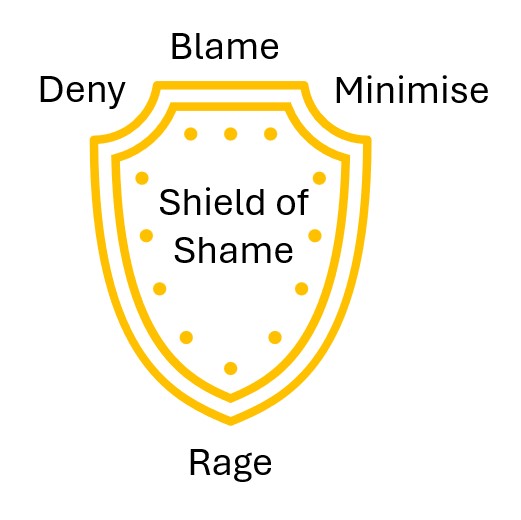The Shield of Shame
2 February 2025
The school one of my husband’s children attends is very experienced at helping kids to feel more secure within educational settings. The environment they create is extremely student-centred and huge emphasis is placed on helping the children develop healthy attachments with adults so that they feel more safe and able to deal with the outside world. They invited us to join a parenting workshop and whilst my instant reaction was ‘erm there’s nothing wrong with my parenting skills thank you very much’, I know they are far more expert than me at dealing with these types of issues plus, quite frankly, we’re grateful for any additional offer of support that we can get.
In one of the sessions I was introduced to the ‘Shield of Shame’. As someone who is usually the person presenting the PowerPoint slide and then talking through the model (love a model) it was really interesting to me to be presented with one that I had absolutely no idea about, but that instantly resonated with me. (They do help! They are important!) Anyway, the teachers explained that a great part of their role was to help their pupils to navigate their instinctive ‘Shield of Shame’ response to the feelings they feel when they do something wrong or even when they feel unloved, incapable or sad.
They explained that shame is a natural and very important thing to feel. People with healthy and normal emotional responses are able to feel the shame and then quickly move into feelings of guilt i.e. they understand that they’ve done something wrong and know the role that they have played in doing that wrong thing. By moving past shame and into guilt they are then able to help the relationship move into the critical last part of the equation – repair. They can mend the relationship and hopefully learn from it.
Shame –> Guilt –> Repair.
Unfortunately, some kids who have experienced trauma, sadness, rejection, have attachment issues or who are neurologically diverse, are hardwired into delivering a primeval, protective response to that shame. They get stuck in it, rage, blame, deny and minimise, pushing people away and preventing them from moving into guilt. As a result they become increasingly isolated and start to lose relationships that are important to them.

The Shield of Shame: What is it & how can we help?
I looked at the shield and recognised each deflective and defensive action immediately. What was illuminating was that I recognised these reactions in other personal relationships too.
All of the 4 points of the Shield of Shame are pretty unpleasant and intensely irritating to deal with. The bottom of the shield, rage, is incredibly irksome of course, but the ones that particularly provoke me – an ardent, truth-telling feminist – are the ones lurking at the top. Denying what happened, minimising the effect of what happened, and then somehow, turning the tables to blame someone else … most irritatingly of all, when this person is me!
In the same way that business language and business models help to articulate and validate what is happening in a business context, knowing that when someone does something wrong and they aren’t emotionally able to maturely move into guilt – that they are going to react with rage, denial, blame and impressive minimisation tactics, helps you to deal with their reactions somehow.
Forewarned is forearmed.
I can’t tell you that it’s all still a breeze to deal with, but it does make you pause and breathe a bit more at least. This Shield of Shame crosses over into my Gender Based Violence work too. A key feature of coercive control relationships or relationships where domestic violence exists is DARVO.
Deny, Attack and Reverse Victim Offender – i.e. when someone has a genuine grievance about something that has happened to them, the perpetrator of that offence has a clever way to shift their blame onto the person that they have hurt. For a recent, non-violent, example, watch this Love Island All Stars argument between Curtis and Ekin Su 8 minutes into episode 18 Love Island All Stars 2 – ITVX (you know I value Love Island as a great teacher of truths.) It’s a rollercoaster all right.
You might be thinking ‘another blog that doesn’t have much business in it’ but the thing is, if your kids can do it to you, your partners, loved ones and friends, then you can bet your bottom dollar it happens in the workplace too.
The best, most productive, workplaces are psychologically safe ones. Places where people can be open and honest about their perspectives and feelings and that these opinions are respected and not minimised or used against them. As a leader, ask yourself, can my employees really be honest with me? Do I genuinely listen to what they have to say, or, if and when they say something that I disagree with, or that makes me feel like I’ve done something wrong or that I’m out of my depth, do I feel threatened? Do I lift up the mighty Shield of Shame to protect both my feelings and my position?
- Marketing Magic
- What’s My Job Again?
- The Reports Have Gone to Her Head
- Cross Stitch Standards and Creativity
- Hefin David and the Aeroplane Arms
- Hankering for a Handbook
- Window of Light
- Defensive Organising
- McMullin’s Tandem of Co-Production
- The Joy of John Parry-Jones
- The Perils of Disappointment
- The Shield of Shame
- Customer Care and Organisation Innovation
- Hooray for Humanity!
- Angry Lemons
- Double Meanings
- Ticketing Masterplans
- When will it all end …
- Lifetime Loyalty and Taylor Swift
- Looking at Things Differently
- Networking Noodles
- Addicted to Truth
- Designs on Service Design
- The Multiple Joys of Universal Design
- Hungry Cultures
- Event Lean
- The Traffic Analogy
- Moving on Up
- Rosé Cava Revolution?
- Powerpoint Sneaky Lean
- Writing about Writing
- ChatGPT Response: Exploring the Art of Expression: Unveiling the Magic of Writing in the Style of Sarah Lethbridge
- Help to Grow Coldplay Style
- Caring IS Everything!
- Institutional Flapping
- “Just Do the Next Right Thing”
- Trust Thermoclines
- Organisational Tempo
- The Inaugural Lethbridge Customer Service Awards
- Vaccine Lean – The Dawn of the Water Spider
- November 2025 (1)
- October 2025 (2)
- September 2025 (1)
- August 2025 (2)
- July 2025 (1)
- June 2025 (1)
- April 2025 (1)
- March 2025 (2)
- February 2025 (1)
- January 2025 (1)
- December 2024 (1)
- November 2024 (1)
- October 2024 (1)
- September 2024 (1)
- July 2024 (2)
- June 2024 (1)
- May 2024 (1)
- March 2024 (1)
- February 2024 (2)
- December 2023 (2)
- October 2023 (2)
- September 2023 (1)
- July 2023 (3)
- June 2023 (1)
- May 2023 (1)
- April 2023 (1)
- March 2023 (1)
- February 2023 (1)
- January 2023 (1)
- November 2022 (1)
- October 2022 (2)
- August 2022 (2)
- July 2022 (1)
- May 2022 (2)
- April 2022 (1)
- February 2022 (1)
- January 2022 (1)
- December 2021 (2)
- November 2021 (1)
- October 2021 (1)
- September 2021 (1)
- August 2021 (1)
- July 2021 (1)
- May 2021 (2)
- April 2021 (1)
- March 2021 (1)
- January 2021 (1)
- December 2020 (1)
- October 2020 (3)
- August 2020 (1)
- June 2020 (2)
- April 2020 (1)
- March 2020 (1)
- February 2020 (1)
- December 2019 (2)
- October 2019 (1)
- September 2019 (1)
- August 2019 (1)
- July 2019 (1)
- June 2019 (1)
- February 2019 (3)
- October 2018 (1)
- September 2018 (1)
- March 2018 (10)
- April 2016 (1)
- January 2015 (3)
- July 2014 (9)
- September 2013 (1)
